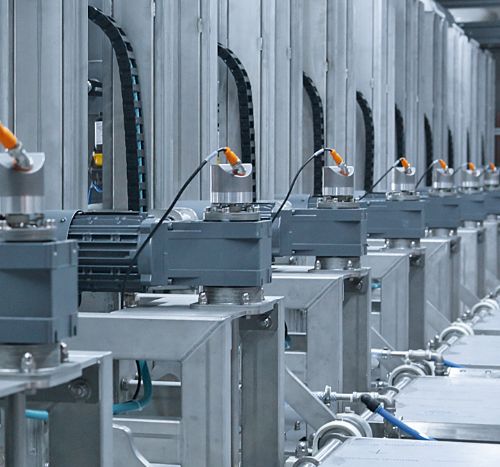Absolute encoders

What if your encoder had absolute position traceability even when unpowered?
ifm’s family of IO-Link encoders has expanded to include multi-turn absolute versions. They will retain absolute position even if the shaft rotates when power is removed. All models have a total resolution of 31 bits (16 bits per rotation, 15 bits number of rotations). Diagnostic information, including bearing operating time, is available via IO-Link for predictive maintenance. A digital input and output allows direct control of machine processes avoiding mechanical offset issues in cutting operations due to delays created by detouring through a PLC. Compared to standard fieldbus multi-turn encoders, wiring is simplified and shielded cables are not required.
Applications
Storage systems
Racking systems have linear and rotating movements. For this purpose, these systems must be monitored and positioned with precision.
- Vertical monitoring
- Monitoring of position and bearing operating time - in contrast to the encoder's total operating hour counter, the bearing operating time is only counted when the shaft rotates.
AGVs and forklifts
For navigation, AGVs and forklifts require:
1. Speed monitoring in rpm
2. Steering angle
For pallet positioning, they require:
3. Fork width
4. Fork height
Cut-to-length
Cut-to-length applications require precise length measurements to accurately cut the material into sections. This family of encoders has both a digital input and output. A position sensor can be used as a trigger to reset the encoder position to zero. After the desired count is reached, an output is sent directly to the machine for the cutting operation. This eliminates time delays and resulting mechanical displacements when signals are sent through a PLC.
- Light spot
- Photoelectric sensor
- IO-Link multi-turn absolute encoder
The y-splitter EVC847 makes connection easy.
Technology
As opposed to incremental encoders, absolute encoders provide a specific numerical value for each angular position of the shaft.
Single turn encoders divide a mechanical revolution (0…360°) into a certain number of measure steps determined by the resolution of the encoder.
Multi-turn encoders provide a unique coded value consisting of the location on the disc (resolution) and the location of the gear train (revolutions).
Common absolute encoder resolutions include 10-bit (1024 steps), 11-bit (2048 steps), 12-bit (4096 steps) and 13-bit (8192 steps). When combining resolution with revolutions, unique steps can be 24-bit or higher.
Absolute encoders are available with parallel, serial or fieldbus outputs to transmit shaft positon data.
- Parallel outputs require an output for each bit of information. For example, a 12-bit parallel output requires 12 separate outputs to transmit the data.
- Synchronous Serial Interface (SSI) is a means to transmit encoder position data serially.
- Common fieldbus outputs include DeviceNet, ProfiNet, Profibus, CANopen, Ethernet IP and EtherCAT. ifm encoders are available with ProfiNet, Profibus and CANopen interfaces.
- ifm offers IO-Link enabled encoders to provide diagnostic information and easy integration into your controls architecture.
Like incremental encoders, absolute encoders use optical and magnetic technology.
Optical absolute encoders have a “ring” of marks for each bit of resolution that will break the light beams. For each additional bit, the number of marks doubles. The inner most ring refers to the MSB (Most Significant Bit) and the outer ring refers to the LSB (Least Significant Bit) of the binary word. The glass disc will generate a unique value for one full rotation. Multi-turn encoders additionally incorporate gears to count the number of rotations.